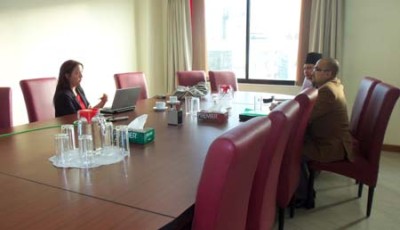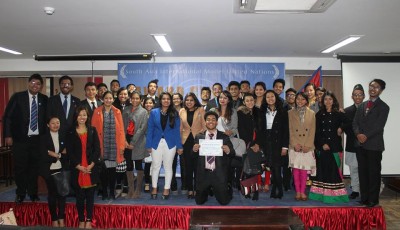South Asia & Pandemic: Collaboration is the only way out!

Amidst the spreading health and financial crisis all over the world due to unprecedented pandemic caused by COVID-19, The British College in Kathmandu has recently conducted a panel discussion on the impact of COVID-19 on South Asian Economies. An excellent panel of experts from different countries discussed the current economic situation in South Asia and the looming crisis. Here are some highlights of the points that emerged during the discussion.
The South Asian region has been shut for more than a month now and it is difficult to prophesize the extent of lockdown amidst an increasing number of deaths and disease. India, Pakistan, and Bangladesh are witnessing 100s of new cases on a daily basis. The World Health Organization is persistently arguing not to lift off the lockdown and threatening that it could turn into a time Bomb any time given the larger population density in their demographics. The situation is complete chaos. It has not only become a health crisis, but also the economic crisis worldwide. Every sector of the economy is in peril. The crisis from both the supply side and demand side is no less than havoc on economies. On the top, the supply chain disruptions, internal and cross-border, are the harsh realities of South Asia this season. Speculations are being forwarded that the current crisis is going to be the mother of all crises in this region. Tourism industries are stifled like never before, the trading business is almost shut, aviation industries are likely to sink into the debt trap, entertainment industries are knocked out, and the agriculture sector is losing market. The World Bank (WB) recently projected the fastest-growing region in the world to shrink down to 1.8 to 2.8 per cent with countries such as Pakistan, Sri Lanka, Afghanistan, and the Maldives having negative growth projections. In the worst-case scenario, WB foresees a negative growth for the region as a whole.
The situation is such that unless the outbreak is contained, markets cannot be opened. But, equally important is to think of possible ways to minimize the risk. This is where South Asian countries need to come to a single platform to wipe the plague out and take the region back on its economic footings. South Asian countries have a long history of economic integration. One such is the South Asian Association of Regional Cooperation (SAARC). Amidst this crisis, on the initiation of Prime Minister of India, Mr Narendra Modi, SAARC countries have created a SAARC COVID-19 Emergency Fund to restrain the Coronavirus. Until now, the emergency fund had accumulated a sum of US$21.8 million. However, the issues remained controversial on the proper utilization of this fund. Therefore, to fight this epidemic, a strong and firm coordination between SAARC countries is needed. For this, the current crisis requires coordination amongst South Asian countries from four fronts: supply chain easing, migrant workers management, collaboration in the health sector, and facilitating government loans.
The region has to come together in helping each other by easing supply chain disruptions. Currently, the supply chain has been disrupted heavily in this region: be the case of agricultural products, or daily consumable goods, or even more importantly the medical supplies. Countries are putting restrictions on critical medicines amid this crisis. This is, in fact, going to be much worrisome rather than a solution. India, being the largest economy in this region and largest supplier of some medicines worldwide, has to take initiative in easing such supply chains and helping other country’s health systems. The unprecedented situation this season cannot be controlled single-handedly. A country such as Nepal, which imports almost everything from India, will be in a dire situation if supply chain disruptions are not taken care of properly. Since these countries are interlinked economically and socially, any crisis in any country could have crisis spillovers to other neighbours too. Therefore, the current need is to ease restrictions on exports of daily consumable goods and required medicines to help to loom food insecurity and health crisis. Time has come to initiate the norms of South Asian Free Trade Agreements (SAFTA), free trade within the reason. At least for a year or two, this region needs a tariff-free flow of critical goods and services across the borders. Critical goods such as medical supplies, agricultural goods, and daily consumable goods need an abrupt withdrawal of tariff and non-tariff quotas.
Similarly, collaboration and coordination in the health sector are also important in the South Asian Region. Most of the countries in this region have weak health facilities. A higher population and weak health system in this region could be a nightmare in controlling this disease. Some of the countries even do not have access to a sufficient number of test kits, medicines, and hospitals for isolation wards. On the top, a larger portion of the population in this region do not have access to clean water, proper education, globes, masks, soap, and so on. With such a dire health system in South Asia, collaboration is what needed at this time of crisis. Countries such as India, who have resources to produce some of the basic kits of prevention, have to come out to help other nations in this fight. SAARC COVID-19 Emergency Fund has to be utilized to make necessary medical equipment available throughout the region. In the long run, It is equally important for countries to come together and make an investment in research and development in the health sector and make this region independent to address possible health crises in the future.
Equally important is the proper management of migrated workers within the region. South Asian countries occupy a larger portion of migrant workers from neighbouring economies. The shutdown of business is leaving these workers jobless. The workers working on a daily basis are very prone to disease and food insecurity. The situation is becoming harsh; they can neither go back to their home country nor stay locked without food to eat and shelter to hide. Since the transportation system is closed largely within countries or across the borders, people are walking miles to make it to their homes. Thousands of workers are stranded at Nepal-India borders on both sides. Due to the fear of an outbreak, governments are reluctant to welcoming their citizens. In the middle of this crisis, governments at the policy level have to ensure their safety and food security. Otherwise, people might start choosing risky approaches to get back to their home countries, which is dangerous for society and their family members.
Finally, during the current economic crisis what is needed is: the proper and inclusive fund management to help disadvantaged and vulnerable communities, people losing jobs and SMEs going bankrupt. The larger portion of the South Asian economy is dominated by service and agriculture sectors; these sectors add up to approximately 73 per cent of the GDP. Except for Bhutan, all other countries have more than 50 per cent contribution of the service sector in their GDPS. The region also has countries such as Maldives whose GDP includes more than 70 per cent of the service sector alone. With these statistics, it is not hard to construe that the pandemic is going to create a total economic devour. In addition, it is important to note that the service and agriculture sectors are the major job creators in this region. Shutting these economies down means creating a spike of jobless people. The revenue through services that can be neither stored nor transferred into the future is likely to force a larger number of SMEs to go bankrupt. With these apprehensive realities, countries are coming up with stimulus packages to support the vulnerable sections of the economy. However, some of the countries in this region are not capable economically to finance this government supports. The only option remaining for such economies is to print money. This should not be the first option though: higher inflation in the region is against such manoeuvres. Therefore, countries in these regions have to help one another by providing the most vulnerable nations with either interest-free loans or soft loans. Otherwise, the social and economic integration in this region is such that problems in one country could easily be transferred to other ones. SAARC COVID-19 Emergency Fund can also be used for the same purpose.
Written by
Jagadish Prasad Bist, Full-Time Faculty, PGBM, The British College Kathmandu, Nepal.
We have published the entire session on our Youtube channel for those who are interested.
Youtube Link: https://youtu.be/PyrgYMmWxuk









